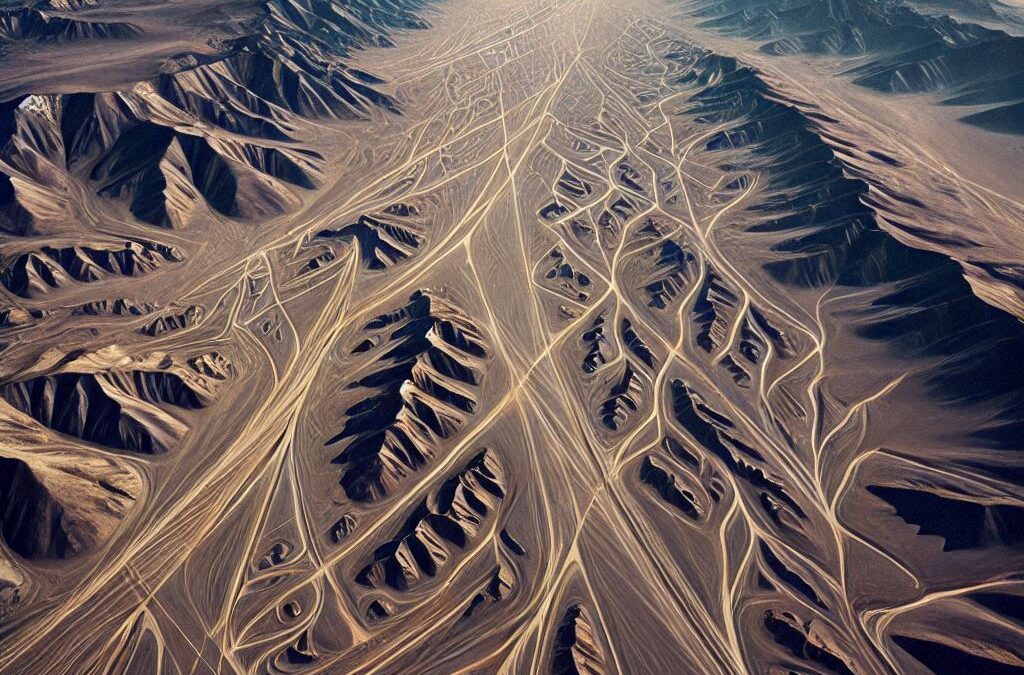In a Nutshell:
The Nasca Lines of Peru, etched into the desert over 2,000 years ago, remain one of humanity’s greatest mysteries. These enormous geoglyphs—depicting animals, plants, and abstract patterns—are thought to reflect the Nasca people’s spiritual beliefs and cosmic awareness. Created with an astounding precision visible only from the air, they demonstrate a profound connection to the Earth and the heavens. What drove the Nasca to create these monumental artworks, and how did their worldview shape these enigmatic designs?
Decoding the Nasca Lines:
The Nasca Lines, stretching across nearly 200 square miles of Peru’s Pampa de Jumana desert, were created between 500 BCE and 500 CE by removing the oxidized top layer of stones to expose the lighter earth below. Their sheer scale and accuracy have inspired countless theories, from ritualistic purposes to celestial alignments.
1. Spiritual Pathways to the Gods:
For the Nasca, spirituality was deeply connected to nature and the cosmos. Archaeologists believe the lines were pathways used in religious rituals, possibly to honor deities tied to fertility and water—a crucial concern in their arid environment. For instance, geoglyphs like the monkey, hummingbird, and spider may have symbolic meanings linked to natural cycles or spiritual protection.
The connection to water is especially significant. Some scholars, like Maria Reiche, propose the lines functioned as ceremonial landscapes, calling upon the gods to bring rain and ensure agricultural prosperity.
2. Cosmic Freedom and Celestial Alignments:
The Nasca’s knowledge of astronomy is evident in the positioning of certain geoglyphs. Some align with the solstices, suggesting an understanding of the movements of celestial bodies. The enormous size and design of the lines imply they were made to be “seen” from above—perhaps by gods, ancestors, or celestial beings in their spiritual beliefs.
The precision required to create these shapes without aerial views is awe-inspiring. Wooden stakes found at geoglyph sites suggest the Nasca used primitive surveying techniques, showcasing their ingenuity and cosmic focus.
3. Artistic Expression and Cultural Identity:
The diversity of designs—ranging from animals and plants to geometric shapes—reflects a sophisticated culture attuned to its environment. The choice of animals, such as the whale and condor, could signify symbolic ties to both terrestrial and divine realms. These artworks were likely not just functional but also a testament to the Nasca’s creativity and their belief in the power of symbols to bridge human and cosmic realms.
4. Technological Marvels Beyond Time:
The Nasca Lines demonstrate a level of coordination and technical skill remarkable for their time. Without modern tools or aerial perspectives, the Nasca likely used ropes, stakes, and grids to map out the designs. These achievements point to a highly organized society capable of large-scale, cooperative projects.
Mystery and Legacy:
The purpose of the Nasca Lines remains speculative, adding to their mystique. Were they offerings to gods, astronomical markers, or artistic expressions of a cosmic worldview? The desert’s dry climate has preserved these ancient masterpieces, allowing modern humanity to marvel at the ingenuity and vision of the Nasca people.
Today, the lines are a UNESCO World Heritage Site, inspiring researchers, artists, and spiritual seekers worldwide. They challenge us to think about humanity’s connection to the Earth and the universe, reminding us that ancient cultures often possessed knowledge far beyond what we give them credit for.
Citations:
- Reiche, Maria. Mystery on the Desert.
- Aveni, Anthony F. Nasca: Eighth Wonder of the World.
- UNESCO World Heritage Site – Nasca Lines: Official Documentation.
Would you like to explore their celestial alignments further, buddy, or dive into other ancient marvels?

